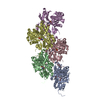+ Open data
Open data
- Basic information
Basic information
| Entry | Database: PDB / ID: 8rv2 | ||||||||||||
|---|---|---|---|---|---|---|---|---|---|---|---|---|---|
| Title | Structure of the formin INF2 bound to the barbed end of F-actin. | ||||||||||||
 Components Components |
| ||||||||||||
 Keywords Keywords |  STRUCTURAL PROTEIN / STRUCTURAL PROTEIN /  actin / actin /  formin / INF2 / actin end / barbed end formin / INF2 / actin end / barbed end | ||||||||||||
| Function / homology |  Function and homology information Function and homology informationcytoskeletal motor activator activity /  regulation of mitochondrial fission / regulation of mitochondrial fission /  tropomyosin binding / tropomyosin binding /  myosin heavy chain binding / mesenchyme migration / myosin heavy chain binding / mesenchyme migration /  troponin I binding / actin filament bundle / filamentous actin / actin filament bundle assembly / skeletal muscle thin filament assembly ...cytoskeletal motor activator activity / troponin I binding / actin filament bundle / filamentous actin / actin filament bundle assembly / skeletal muscle thin filament assembly ...cytoskeletal motor activator activity /  regulation of mitochondrial fission / regulation of mitochondrial fission /  tropomyosin binding / tropomyosin binding /  myosin heavy chain binding / mesenchyme migration / myosin heavy chain binding / mesenchyme migration /  troponin I binding / actin filament bundle / filamentous actin / actin filament bundle assembly / skeletal muscle thin filament assembly / striated muscle thin filament / skeletal muscle myofibril / actin monomer binding / skeletal muscle fiber development / troponin I binding / actin filament bundle / filamentous actin / actin filament bundle assembly / skeletal muscle thin filament assembly / striated muscle thin filament / skeletal muscle myofibril / actin monomer binding / skeletal muscle fiber development /  stress fiber / stress fiber /  titin binding / actin filament polymerization / titin binding / actin filament polymerization /  filopodium / filopodium /  actin filament / actin filament /  Hydrolases; Acting on acid anhydrides; Acting on acid anhydrides to facilitate cellular and subcellular movement / Hydrolases; Acting on acid anhydrides; Acting on acid anhydrides to facilitate cellular and subcellular movement /  small GTPase binding / calcium-dependent protein binding / small GTPase binding / calcium-dependent protein binding /  lamellipodium / lamellipodium /  cell body / cell body /  actin binding / actin binding /  hydrolase activity / protein domain specific binding / hydrolase activity / protein domain specific binding /  calcium ion binding / positive regulation of gene expression / perinuclear region of cytoplasm / magnesium ion binding / calcium ion binding / positive regulation of gene expression / perinuclear region of cytoplasm / magnesium ion binding /  ATP binding / identical protein binding / ATP binding / identical protein binding /  cytoplasm cytoplasmSimilarity search - Function | ||||||||||||
| Biological species |   Homo sapiens (human) Homo sapiens (human)  Oryctolagus cuniculus (rabbit) Oryctolagus cuniculus (rabbit) | ||||||||||||
| Method |  ELECTRON MICROSCOPY / ELECTRON MICROSCOPY /  single particle reconstruction / single particle reconstruction /  cryo EM / Resolution: 3.41 Å cryo EM / Resolution: 3.41 Å | ||||||||||||
 Authors Authors | Oosterheert, W. / Boiero Sanders, M. / Funk, J. / Prumbaum, D. / Raunser, S. / Bieling, P. | ||||||||||||
| Funding support |  Germany, European Union, 3items Germany, European Union, 3items
| ||||||||||||
 Citation Citation |  Journal: Science / Year: 2024 Journal: Science / Year: 2024Title: Molecular mechanism of actin filament elongation by formins. Authors: Wout Oosterheert / Micaela Boiero Sanders / Johanna Funk / Daniel Prumbaum / Stefan Raunser / Peter Bieling /  Abstract: Formins control the assembly of actin filaments (F-actin) that drive cell morphogenesis and motility in eukaryotes. However, their molecular interaction with F-actin and their mechanism of action ...Formins control the assembly of actin filaments (F-actin) that drive cell morphogenesis and motility in eukaryotes. However, their molecular interaction with F-actin and their mechanism of action remain unclear. In this work, we present high-resolution cryo-electron microscopy structures of F-actin barbed ends bound by three distinct formins, revealing a common asymmetric formin conformation imposed by the filament. Formation of new intersubunit contacts during actin polymerization sterically displaces formin and triggers its translocation. This "undock-and-lock" mechanism explains how actin-filament growth is coordinated with formin movement. Filament elongation speeds are controlled by the positioning and stability of actin-formin interfaces, which distinguish fast and slow formins. Furthermore, we provide a structure of the actin-formin-profilin ring complex, which resolves how profilin is rapidly released from the barbed end during filament elongation. | ||||||||||||
| History |
|
- Structure visualization
Structure visualization
| Structure viewer | Molecule:  Molmil Molmil Jmol/JSmol Jmol/JSmol |
|---|
- Downloads & links
Downloads & links
- Download
Download
| PDBx/mmCIF format |  8rv2.cif.gz 8rv2.cif.gz | 443.8 KB | Display |  PDBx/mmCIF format PDBx/mmCIF format |
|---|---|---|---|---|
| PDB format |  pdb8rv2.ent.gz pdb8rv2.ent.gz | 352.8 KB | Display |  PDB format PDB format |
| PDBx/mmJSON format |  8rv2.json.gz 8rv2.json.gz | Tree view |  PDBx/mmJSON format PDBx/mmJSON format | |
| Others |  Other downloads Other downloads |
-Validation report
| Arichive directory |  https://data.pdbj.org/pub/pdb/validation_reports/rv/8rv2 https://data.pdbj.org/pub/pdb/validation_reports/rv/8rv2 ftp://data.pdbj.org/pub/pdb/validation_reports/rv/8rv2 ftp://data.pdbj.org/pub/pdb/validation_reports/rv/8rv2 | HTTPS FTP |
|---|
-Related structure data
| Related structure data |  19522MC  8rtyC 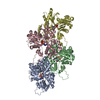 8ru0C 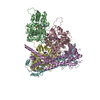 8ru2C C: citing same article ( M: map data used to model this data |
|---|---|
| Similar structure data | Similarity search - Function & homology  F&H Search F&H Search |
- Links
Links
- Assembly
Assembly
| Deposited unit | 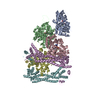
|
|---|---|
| 1 |
|
- Components
Components
-Protein , 2 types, 6 molecules ABCDEF
| #1: Protein |  / Alpha-actin-1 / Alpha-actin-1Mass: 41875.633 Da / Num. of mol.: 4 / Source method: isolated from a natural source Details: Rabbit skeletal alpha actin purified from frozen rabbit muscle acetone powder. Source: (natural)   Oryctolagus cuniculus (rabbit) / Tissue: Skeletal muscle Oryctolagus cuniculus (rabbit) / Tissue: Skeletal muscle / References: UniProt: P68135 / References: UniProt: P68135#2: Protein | Mass: 84453.711 Da / Num. of mol.: 2 Source method: isolated from a genetically manipulated source Details: INF2 FH1FH2C nonCAAX isoform was recombinantly expressed in E. coli BL21 Star pRARE cells and purified. This compound consists of the formin homology 1 and 2 domains, as well as the C- ...Details: INF2 FH1FH2C nonCAAX isoform was recombinantly expressed in E. coli BL21 Star pRARE cells and purified. This compound consists of the formin homology 1 and 2 domains, as well as the C-terminal region of the human formin INF2 isoform nonCAAX. Source: (gene. exp.)   Homo sapiens (human) / Gene: INF2, C14orf151, C14orf173 / Plasmid: pETMz2 expression vector Homo sapiens (human) / Gene: INF2, C14orf151, C14orf173 / Plasmid: pETMz2 expression vectorDetails (production host): Insert: His6-Z-TEV-Gly5-INF2(FH1FH2C) Production host:   Escherichia coli (E. coli) / Strain (production host): BL21 Star pRARE / References: UniProt: Q27J81 Escherichia coli (E. coli) / Strain (production host): BL21 Star pRARE / References: UniProt: Q27J81 |
|---|
-Non-polymers , 4 types, 9 molecules 






| #3: Chemical |  Adenosine diphosphate Adenosine diphosphate#4: Chemical | ChemComp-MG / #5: Chemical | ChemComp-PO4 / |  Phosphate Phosphate#6: Chemical | ChemComp-ATP / |  Adenosine triphosphate Adenosine triphosphate |
|---|
-Details
| Has ligand of interest | Y |
|---|
-Experimental details
-Experiment
| Experiment | Method:  ELECTRON MICROSCOPY ELECTRON MICROSCOPY |
|---|---|
| EM experiment | Aggregation state: PARTICLE / 3D reconstruction method:  single particle reconstruction single particle reconstruction |
- Sample preparation
Sample preparation
| Component |
| |||||||||||||||||||||||||||||||||||
|---|---|---|---|---|---|---|---|---|---|---|---|---|---|---|---|---|---|---|---|---|---|---|---|---|---|---|---|---|---|---|---|---|---|---|---|---|
| Molecular weight |
| |||||||||||||||||||||||||||||||||||
| Source (natural) |
| |||||||||||||||||||||||||||||||||||
| Source (recombinant) |
| |||||||||||||||||||||||||||||||||||
| Buffer solution | pH: 7.1 Details: 12 mM HEPES pH 7.1, 100 mM KCl, 2.1 mM MgCl2, 1 mM EGTA, 1 mM TCEP, 0.2 mM ATP | |||||||||||||||||||||||||||||||||||
| Buffer component |
| |||||||||||||||||||||||||||||||||||
| Specimen | Embedding applied: NO / Shadowing applied: NO / Staining applied : NO / Vitrification applied : NO / Vitrification applied : YES : YES | |||||||||||||||||||||||||||||||||||
| Specimen support | Grid material: GOLD / Grid mesh size: 200 divisions/in. / Grid type: Quantifoil R2/1 | |||||||||||||||||||||||||||||||||||
Vitrification | Instrument: FEI VITROBOT MARK IV / Cryogen name: ETHANE-PROPANE / Humidity: 100 % / Chamber temperature: 286 K / Details: 3 seconds, force 0. |
- Electron microscopy imaging
Electron microscopy imaging
| Experimental equipment |  Model: Titan Krios / Image courtesy: FEI Company |
|---|---|
| Microscopy | Model: FEI TITAN KRIOS Details: 300 kV Titan Krios G3 microscope (Thermo Fisher Scientific). |
| Electron gun | Electron source : :  FIELD EMISSION GUN / Accelerating voltage: 300 kV / Illumination mode: FLOOD BEAM FIELD EMISSION GUN / Accelerating voltage: 300 kV / Illumination mode: FLOOD BEAM |
| Electron lens | Mode: BRIGHT FIELD Bright-field microscopy / Nominal magnification: 105000 X / Nominal defocus max: 2900 nm / Nominal defocus min: 1300 nm / Cs Bright-field microscopy / Nominal magnification: 105000 X / Nominal defocus max: 2900 nm / Nominal defocus min: 1300 nm / Cs : 2.7 mm / C2 aperture diameter: 50 µm : 2.7 mm / C2 aperture diameter: 50 µm |
| Specimen holder | Cryogen: NITROGEN / Specimen holder model: FEI TITAN KRIOS AUTOGRID HOLDER |
| Image recording | Electron dose: 60.6 e/Å2 / Film or detector model: GATAN K3 BIOQUANTUM (6k x 4k) / Num. of grids imaged: 1 / Num. of real images: 20305 |
| EM imaging optics | Energyfilter name : GIF Bioquantum / Details: Gatan energy filter. / Energyfilter slit width: 15 eV : GIF Bioquantum / Details: Gatan energy filter. / Energyfilter slit width: 15 eVSpherical aberration corrector  : 300 kV Titan Krios G3 microscope (Thermo Fisher Scientific). : 300 kV Titan Krios G3 microscope (Thermo Fisher Scientific). |
- Processing
Processing
| EM software |
| ||||||||||||||||||||||||||||||||||||||||||||||||
|---|---|---|---|---|---|---|---|---|---|---|---|---|---|---|---|---|---|---|---|---|---|---|---|---|---|---|---|---|---|---|---|---|---|---|---|---|---|---|---|---|---|---|---|---|---|---|---|---|---|
CTF correction | Type: PHASE FLIPPING AND AMPLITUDE CORRECTION | ||||||||||||||||||||||||||||||||||||||||||||||||
| Particle selection | Num. of particles selected: 1935707 / Details: Particles picked using SPHIRE-crYOLO. | ||||||||||||||||||||||||||||||||||||||||||||||||
| Symmetry | Point symmetry : C1 (asymmetric) : C1 (asymmetric) | ||||||||||||||||||||||||||||||||||||||||||||||||
3D reconstruction | Resolution: 3.41 Å / Resolution method: FSC 0.143 CUT-OFF / Num. of particles: 142549 / Symmetry type: POINT | ||||||||||||||||||||||||||||||||||||||||||||||||
| Atomic model building | Protocol: FLEXIBLE FIT / Space: REAL / Details: Real Space Refinement in Phenix. | ||||||||||||||||||||||||||||||||||||||||||||||||
| Atomic model building | 3D fitting-ID: 1
| ||||||||||||||||||||||||||||||||||||||||||||||||
| Refine LS restraints |
|
 Movie
Movie Controller
Controller








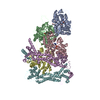
 PDBj
PDBj







